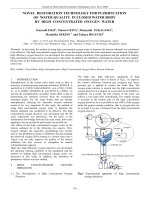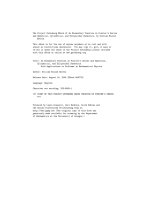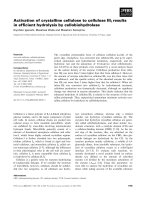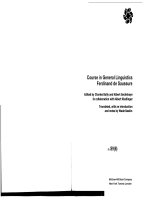An Elementary Course in Synthetic Projective Geometry by Lehmer pot
Bạn đang xem bản rút gọn của tài liệu. Xem và tải ngay bản đầy đủ của tài liệu tại đây (2.96 MB, 512 trang )
The Project Gutenberg EBook of An
Elementary Course in Synthetic Projective
Geometry by Lehmer, Derrick Norman
This eBook is for the use of anyone
anywhere at no cost and with almost no
restrictions whatsoever. You may copy it,
give it away or re-use it under the terms of
the Project Gutenberg License included
with this eBook or online at
/>Title: An Elementary Course in Synthetic
Projective Geometry
Author: Lehmer, Derrick Norman
Release Date: November 4, 2005 [Ebook
#17001]
Language: English
***START OF THE PROJECT GUTENBERG EBOOK AN
ELEMENTARY COURSE IN SYNTHETIC PROJECTIVE
GEOMETRY***
An Elementary Course in
Synthetic Projective
Geometry
by Lehmer, Derrick
Norman
Edition 1, (November 4, 2005)
Preface
The following course is intended to give,
in as simple a way as possible, the
essentials of synthetic projective
geometry. While, in the main, the theory is
developed along the well-beaten track
laid out by the great masters of the subject,
it is believed that there has been a slight
smoothing of the road in some places.
Especially will this be observed in the
chapter on Involution. The author has
never felt satisfied with the usual
treatment of that subject by means of
circles and anharmonic ratios. A purely
projective notion ought not to be based on
metrical foundations. Metrical
developments should be made there, as
elsewhere in the theory, by the
introduction of infinitely distant elements.
The author has departed from the century-
old custom of writing in parallel columns
each theorem and its dual. He has not
found that it conduces to sharpness of
vision to try to focus his eyes on two
things at once. Those who prefer the usual
method of procedure can, of course,
develop the two sets of theorems side by
side; the author has not found this the
better plan in actual teaching.
As regards nomenclature, the author has
followed the lead of the earlier writers in
English, and has called the system of lines
in a plane which all pass through a point a
pencil of rays instead of a bundle of rays,
as later writers seem inclined to do. For a
point considered as made up of all the
lines and planes through it he has ventured
to use the term point system, as being the
natural dualization of the usual term plane
system. He has also rejected the term foci
of an involution, and has not used the
customary terms for classifying
involutions—hyperbolic involution,
elliptic involution and parabolic
involution. He has found that all these
terms are very confusing to the student,
who inevitably tries to connect them in
some way with the conic sections.
Enough examples have been provided to
give the student a clear grasp of the
theory. Many are of sufficient generality to
serve as a basis for individual
investigation on the part of the student.
Thus, the third example at the end of the
first chapter will be found to be very
fruitful in interesting results. A
correspondence is there indicated
between lines in space and circles through
a fixed point in space. If the student will
trace a few of the consequences of that
correspondence, and determine what
configurations of circles correspond to
intersecting lines, to lines in a plane, to
lines of a plane pencil, to lines cutting
three skew lines, etc., he will have
acquired no little practice in picturing to
himself figures in space.
The writer has not followed the usual
practice of inserting historical notes at the
foot of the page, and has tried instead, in
the last chapter, to give a consecutive
account of the history of pure geometry,
or, at least, of as much of it as the student
will be able to appreciate who has
mastered the course as given in the
preceding chapters. One is not apt to get a
very wide view of the history of a subject
by reading a hundred biographical
footnotes, arranged in no sort of sequence.
The writer, moreover, feels that the
proper time to learn the history of a
subject is after the student has some
general ideas of the subject itself.
The course is not intended to furnish an
illustration of how a subject may be
developed, from the smallest possible
number of fundamental assumptions. The
author is aware of the importance of work
of this sort, but he does not believe it is
possible at the present time to write a
book along such lines which shall be of
much use for elementary students. For the
purposes of this course the student should
have a thorough grounding in ordinary
elementary geometry so far as to include
the study of the circle and of similar
triangles. No solid geometry is needed
beyond the little used in the proof of
Desargues' theorem (25), and, except in
certain metrical developments of the
general theory, there will be no call for a
knowledge of trigonometry or analytical
geometry. Naturally the student who is
equipped with these subjects as well as
with the calculus will be a little more
mature, and may be expected to follow the
course all the more easily. The author has
had no difficulty, however, in presenting it
to students in the freshman class at the
University of California.
The subject of synthetic projective
geometry is, in the opinion of the writer,
destined shortly to force its way down
into the secondary schools; and if this
little book helps to accelerate the
movement, he will feel amply repaid for
the task of working the materials into a
form available for such schools as well as
for the lower classes in the university.
The material for the course has been
drawn from many sources. The author is
chiefly indebted to the classical works of
Reye, Cremona, Steiner, Poncelet, and
Von Staudt. Acknowledgments and thanks
are also due to Professor Walter C. Eells,
of the U.S. Naval Academy at Annapolis,
for his searching examination and keen
criticism of the manuscript; also to
Professor Herbert Ellsworth Slaught, of
The University of Chicago, for his many
valuable suggestions, and to Professor B.
M. Woods and Dr. H. N. Wright, of the
University of California, who have tried
out the methods of presentation, in their
own classes.
D. N. LEHMER
Berkeley, California
Contents
Preface
Contents
CHAPTER I - ONE-TO-ONE
CORRESPONDENCE
1. Definition of one-to-one
correspondence
2. Consequences of one-to-one
correspondence
3. Applications in mathematics
4. One-to-one correspondence and
enumeration
5. Correspondence between a part
and the whole
6. Infinitely distant point
7. Axial pencil; fundamental forms
8. Perspective position
9. Projective relation
10. Infinity-to-one correspondence
11. Infinitudes of different orders
12. Points in a plane
13. Lines through a point
14. Planes through a point
15. Lines in a plane
16. Plane system and point system
17. Planes in space
18. Points of space
19. Space system
20. Lines in space
21. Correspondence between points
and numbers
22. Elements at infinity
PROBLEMS
CHAPTER II - RELATIONS BETWEEN
FUNDAMENTAL FORMS IN ONE-TO-
ONE CORRESPONDENCE WITH
EACH OTHER
23. Seven fundamental forms
24. Projective properties
25. Desargues's theorem
26. Fundamental theorem concerning
two complete quadrangles
27. Importance of the theorem
28. Restatement of the theorem
29. Four harmonic points
30. Harmonic conjugates
31. Importance of the notion of four
harmonic points
32. Projective invariance of four
harmonic points
33. Four harmonic lines
34. Four harmonic planes
35. Summary of results
36. Definition of projectivity
37. Correspondence between
harmonic conjugates
38. Separation of harmonic
conjugates
39. Harmonic conjugate of the point
at infinity
40. Projective theorems and metrical
theorems. Linear construction
41. Parallels and mid-points
42. Division of segment into equal
parts
43. Numerical relations
44. Algebraic formula connecting
four harmonic points
45. Further formulae
46. Anharmonic ratio
PROBLEMS
CHAPTER III - COMBINATION OF
TWO PROJECTIVELY RELATED
FUNDAMENTAL FORMS
47. Superposed fundamental forms.
Self-corresponding elements
48. Special case
49. Fundamental theorem. Postulate
of continuity
50. Extension of theorem to pencils
of rays and planes
51. Projective point-rows having a
self-corresponding point in common
52. Point-rows in perspective
position
53. Pencils in perspective position
54. Axial pencils in perspective
position
55. Point-row of the second order
56. Degeneration of locus
57. Pencils of rays of the second
order
58. Degenerate case
59. Cone of the second order
PROBLEMS
CHAPTER IV - POINT-ROWS OF THE
SECOND ORDER
60. Point-row of the second order
defined
61. Tangent line
62. Determination of the locus
63. Restatement of the problem
64. Solution of the fundamental
problem
65. Different constructions for the
figure
66. Lines joining four points of the
locus to a fifth
67. Restatement of the theorem
68. Further important theorem
69. Pascal's theorem
70. Permutation of points in Pascal's
theorem
71. Harmonic points on a point-row
of the second order
72. Determination of the locus
73. Circles and conics as point-rows
of the second order
74. Conic through five points
75. Tangent to a conic
76. Inscribed quadrangle
77. Inscribed triangle
78. Degenerate conic
PROBLEMS
CHAPTER V - PENCILS OF RAYS OF
THE SECOND ORDER
79. Pencil of rays of the second order
defined
80. Tangents to a circle
81. Tangents to a conic
82. Generating point-rows lines of
the system
83. Determination of the pencil
84. Brianchon's theorem
85. Permutations of lines in
Brianchon's theorem
86. Construction of the penvil by
Brianchon's theorem
87. Point of contact of a tangent to a
conic
88. Circumscribed quadrilateral
89. Circumscribed triangle
90. Use of Brianchon's theorem
91. Harmonic tangents
92. Projectivity and perspectivity
93. Degenerate case
94. Law of duality
PROBLEMS
CHAPTER VI - POLES AND POLARS
95. Inscribed and circumscribed
quadrilaterals
96. Definition of the polar line of a
point
97. Further defining properties
98. Definition of the pole of a line
99. Fundamental theorem of poles
and polars
100. Conjugate points and lines
101. Construction of the polar line of
a given point
102. Self-polar triangle
103. Pole and polar projectively
related
104. Duality
105. Self-dual theorems
106. Other correspondences
PROBLEMS
CHAPTER VII - METRICAL
PROPERTIES OF THE CONIC
SECTIONS
107. Diameters. Center
108. Various theorems
109. Conjugate diameters
110. Classification of conics
111. Asymptotes
112. Various theorems
113. Theorems concerning
asymptotes
114. Asymptotes and conjugate
diameters
115. Segments cut off on a chord by
hyperbola and its asymptotes
116. Application of the theorem
117. Triangle formed by the two
asymptotes and a tangent
118. Equation of hyperbola referred
to the asymptotes
119. Equation of parabola
120. Equation of central conics
referred to conjugate diameters
PROBLEMS
CHAPTER VIII - INVOLUTION
121. Fundamental theorem
122. Linear construction
123. Definition of involution of
points on a line
124. Double-points in an involution
125. Desargues's theorem concerning
conics through four points
126. Degenerate conics of the system
127. Conics through four points
touching a given line
128. Double correspondence
129. Steiner's construction
130. Application of Steiner's
construction to double
correspondence
131. Involution of points on a point-
row of the second order.
132. Involution of rays
133. Double rays
134. Conic through a fixed point
touching four lines
135. Double correspondence
136. Pencils of rays of the second
order in involution
137. Theorem concerning pencils of
the second order in involution
138. Involution of rays determined by
a conic
139. Statement of theorem
140. Dual of the theorem
PROBLEMS
CHAPTER IX - METRICAL
PROPERTIES OF INVOLUTIONS
141. Introduction of infinite point;
center of involution
142. Fundamental metrical theorem
143. Existence of double points
144. Existence of double rays
145. Construction of an involution by
means of circles
146. Circular points
147. Pairs in an involution of rays
which are at right angles. Circular
involution
148. Axes of conics
149. Points at which the involution
determined by a conic is circular









